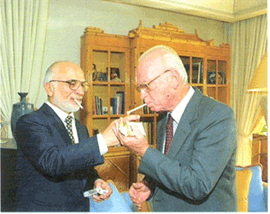STRIVING
FOR PEACE - In early 1990, Defense
Minister Yitzhak Rabin was not a
happy man. The Labor-Likud coalition
government, under the Likud prime
minister Yitzhak Shamir, had been
spinning its wheels endlessly on
several peace initiatives that Rabin
felt were crucial to Israel’s
security. Having already shot down
meetings with Jordan’s King
Hussein, Shamir infuriated Rabin
at a March cabinet meeting by stubbornly
rejecting any proposal for Palestinian
representation at upcoming peace
talks. This finally drove Rabin
to back his longtime rival, Labor
head Shimon Peres, in dissolving
the coalition. Peres, however, soon
lost Rabin’s already-reluctant
support when his cobbled-together
Labor coalition fell apart from
a mess of political defections and
rejection by Orthodox rabbis, actually
allowing Likud to gain power again.
Rabin immediately blasted the entire
plan as a “stinking maneuver”,
and decided to take things into
his own hands. By June of 1992,
he had won Labor Party leadership
along with the Israeli general elections.
The stage was set for three turbulent
years of groundbreaking change.
Yet to many, the biggest shock was
Rabin’s grudging reconciliation
with Peres, largely due to their
shared interest in peace.
 |
Rabin
and Hussein sharing a light
moment |
 Rabin
now held the reins of power in Israeli
government along with a majority
in the Knesset, Israel’s parliament,
that was big enough to defeat any
Likud attempts to stall his initiatives.
He would need every ounce of leverage
for the upcoming months –
a mercilessly frenetic scramble
to forge lasting peace on two fronts,
simultaneously, against countless
obstacles outside and inside Israel’s
borders. The peace negotiations
with Jordan were a prime example
of these problems. After long months
of dragging out the talks, the Jordanians
finally signed the Israeli peace
agenda in September 1993. Rabin
visited King Hussein in his private
yacht to seal the agreement –
only to see Jordan nearly pull out
of the entire plan. In his excitement,
Shimon Peres had come close to inadvertently
leaking the secret date of the formal
treaty signing to the Israeli press.
Rabin would now have to wait until
May 1994 to pick up where he had
left off. He and his team worked
with Hussein and the Jordanians
in London well past midnight, paving
the way for Shimon Peres to become
the first Israeli minister openly
received in Jordan when he flew
in on June 20th. In his usual manner,
Peres proclaimed that his trip “took
only 15 minutes, but it crossed
a gulf of 46 years of hatred and
war.” Watching him, Rabin
fumed that Peres was stealing his
place in the spotlight. At their
final meeting in October 1994, Rabin
and Hussein toiled from 9:00 in
the morning to 4:00 the next morning.
With U.S. President Bill Clinton
watching, Rabin and Hussein finally
signed the formal treaty on October
26, 1994. It had been a long, exhausting
road. The most grueling work, however,
was still ahead.
Rabin
now held the reins of power in Israeli
government along with a majority
in the Knesset, Israel’s parliament,
that was big enough to defeat any
Likud attempts to stall his initiatives.
He would need every ounce of leverage
for the upcoming months –
a mercilessly frenetic scramble
to forge lasting peace on two fronts,
simultaneously, against countless
obstacles outside and inside Israel’s
borders. The peace negotiations
with Jordan were a prime example
of these problems. After long months
of dragging out the talks, the Jordanians
finally signed the Israeli peace
agenda in September 1993. Rabin
visited King Hussein in his private
yacht to seal the agreement –
only to see Jordan nearly pull out
of the entire plan. In his excitement,
Shimon Peres had come close to inadvertently
leaking the secret date of the formal
treaty signing to the Israeli press.
Rabin would now have to wait until
May 1994 to pick up where he had
left off. He and his team worked
with Hussein and the Jordanians
in London well past midnight, paving
the way for Shimon Peres to become
the first Israeli minister openly
received in Jordan when he flew
in on June 20th. In his usual manner,
Peres proclaimed that his trip “took
only 15 minutes, but it crossed
a gulf of 46 years of hatred and
war.” Watching him, Rabin
fumed that Peres was stealing his
place in the spotlight. At their
final meeting in October 1994, Rabin
and Hussein toiled from 9:00 in
the morning to 4:00 the next morning.
With U.S. President Bill Clinton
watching, Rabin and Hussein finally
signed the formal treaty on October
26, 1994. It had been a long, exhausting
road. The most grueling work, however,
was still ahead.
<continue>
Making
History //
<striving
for peace> <the
road to Oslo> <winning
the peace prize>
